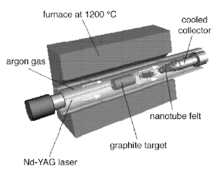The chemists at Rice do a lot of serious things, as you’ll note by just clicking the "science" button on our homepage.
Whether it’s efficiently turning glycerin into ethanol, using new biological processes to grow drugs, creating new kinds of chips, or just curing cancer (to cite just a few of our stories from the last six months), the Owls got it going on.
They’re the New England Patriots of chemistry.
So guess which Rice breakthrough finally caught the imagination of the world’s press?
A blacker black. The new black. Yes, those boffins and their colors.
The story has gone worldwide. The darkest of them all is the headline from India. No really, this stuff is dark.
Earth to journalism. Dr. Ajayan (Banaras Hindu University ’85 — go BHU) and his team were not looking for something new for Kate Moss might wear on a runway, or for Britney to put on for the Brad Renfro funeral. (Although going there might sober her up.)
This is serious science, with serious implications.
What’s the biggest problem in building better solar panels? Well, if you look at them there, all bright and shiny, you got it. They’re reflecting most of the light. Capture more of it, and your efficiency rises.
Any industrial application which depends on the harvesting of light can benefit. You can use more tubes or fewer, adjusting the collection accordingly. Want a better space telescope that captures all the light from the stars through the aperture? Hmmm…..
There remains the big problem of cost. Rice has made several breakthroughs in the production of nanotubes over the last few years, and just last month UC-Riverside scientists found ways to cross into the biological production of tubes. Raymor Industries is among the companies which is now in volume production of tubes, if by volume you mean 10 kilograms a day. (In this article, Chinese scientists ponder the production question.)
Then there is the problem of scaling-up production of the material Dr. Ajayan has created here, which consists of little forests of tubes all standing on their ends. Not always easy, certainly not cheap. Lots of work still to do.
The nanotube revolution is still to come, but it is coming. And it’s going to change everything you think you know about materials and their properties.
Rice science marches on.












